- Who We Are
- What We Do
- Success Stories
- Careers
- News & Events
- Contact us
This year has brought about significant changes in everyone’s lives after Coronavirus began its terrifying reign. The pandemic has impacted the whole world and left everyone in shambles, trying to figure out how to get back up and survive the rest of the year in one piece.
Doctors, scientists, researchers, and all the other medical workers across the globe continue to try and contain the virus and prevent the disease from taking more lives. A key method of handling the situation and maintaining the welfare of the public is through contact tracing.

What is Contact Tracing?
Contact tracing is used to keep the infection of COVID-19 from spreading further. It’s an integral element of outbreak control initiated by public health experts worldwide.
It happens when an individual is COVID-19 positive, and that person is contacted and expected to cooperate with the health authorities. They will be asked to enumerate the other people they came into contact with during the days leading up to the release of their positive test results. As soon as the authorities finish the background check, ‘First contacts’ will be contacted right away to get them checked too.
Only when all the people who crossed paths with the person infected are informed will they then be advised on the precautionary methods they need to take. It includes undergoing self-isolation and boosting their immune system to prevent the risk of infection.
If groups of people are involved and are labeled as high-risk cases, the people in charge will keep track of their activities and whereabouts to ensure no more positive cases come up. The moment they feel sick, they will be tested and treated for COVID-19 right away to prevent the further spread of the virus.
When the individuals who tested positive come from a different country or location, the public health authorities will be contacted immediately to contain the situation. Doing so helps both countries involved to perform the necessary investigations, reaching out to potential contacts to keep the virus from infecting more people.
How Contact Tracing Works
There are labs assigned to take specimens of the tests coming from people who are thought to be positive for COVID-19. Specialists will assess each sample to determine if a person has been infected by the deadly virus.
When someone turns out positive, they will be interviewed further regarding the places they visited and the people they’ve seen during the days leading up to the moment they felt sick. For infected travelers coming from other countries, they will be asked about their whereabouts and information related to the people they have met.
The details gathered from the interviews are used to create a profile of the list of people that needs to be contacted soon, including family members, friends, and people they traveled with. Close contact doesn’t involve strangers you pass by in public, but those you’ve initiated a face-to-face contact with that lasted more than fifteen minutes without practicing social distancing.
When each of the individuals that an infected person has come into close contact with have been successfully noted, they will be further divided into categories, namely high risk or low risk. Afterward, they will be reached out to one by one to let them know of the situation, including the safety precautions they need to take to avoid the chances of getting sick.
Since family members, friends, and colleagues that may have been in contact with a COVID-19 positive person are easier to locate, there won’t be any problem on that part. Regarding international visitors, the assistance of the airlines, border officers, and other authorities in charge will be needed to help make the situation easier to handle!
Conclusion
Even before the COVID-19 pandemic, contact tracing has long been one of the approaches used for tackling the widespread infection of diseases and preventing the outbreaks from becoming worse. It’s a method that provides rapid results because it allows individuals to be located and tested right away to give assistance and information as needed. While contact tracing can keep the public safe to a certain extent, people are still advised to stay home, wash their hands, practice social distancing guidelines, and maintain a healthy immune system to really combat the spread of the COVID-19 pandemic.
Are you looking for IT consulting services to help provide modern solutions against COVID-19? Informatics with its active track record with Sri Lankan Immigration & Emigration, Mauritius Board Control offers custom-software development and infrastructure solutions to clients in need. Get in touch with us today to find out more information about what we do and how we do it!
Written by Daniele Paoletti
